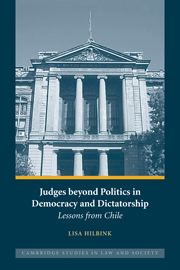Book contents
- Frontmatter
- Contents
- Acknowledgments
- Introduction
- 1 The Judiciary, the Rule of Law, and Democracy: Aspirations and Impediments
- 2 The Institutional Construction of the Judicial Role in Chile
- 3 Conservative Activism in the Heyday of Democracy, 1964–1973
- 4 Legitimizing Authoritarianism, 1973–1990
- 5 Continuity and Change after the Return to Democracy, 1990–2000
- 6 Conclusions and Implications
- Appendix A Orienting Information on Chilean Law and Courts
- Appendix B List of Interviewees (alphabetical by category)
- References
- Index
5 - Continuity and Change after the Return to Democracy, 1990–2000
Published online by Cambridge University Press: 08 January 2010
- Frontmatter
- Contents
- Acknowledgments
- Introduction
- 1 The Judiciary, the Rule of Law, and Democracy: Aspirations and Impediments
- 2 The Institutional Construction of the Judicial Role in Chile
- 3 Conservative Activism in the Heyday of Democracy, 1964–1973
- 4 Legitimizing Authoritarianism, 1973–1990
- 5 Continuity and Change after the Return to Democracy, 1990–2000
- 6 Conclusions and Implications
- Appendix A Orienting Information on Chilean Law and Courts
- Appendix B List of Interviewees (alphabetical by category)
- References
- Index
Summary
On March 11, 1990, General Augusto Pinochet transferred the presidential sash to Patricio Aylwin Azócar, thereby bringing military rule to a formal end. Aylwin had been elected as the candidate of the Concertación de Partidos para la Democracia, which had formed out of the Concertación por el No organized for the 1988 plebiscite. He won the presidency with 55 percent of the popular vote, and the Concertación won 72 of 120 seats in the Chamber of Deputies and 22 of the 38 elected seats in the Senate.
On coming to power, the Concertación's top priority was to “reconstruct and consolidate democracy to ensure that the rule of law would be secured” (Oppenheim 1993: 206). As one Chilean author observes, “During the years of resistance to the dictatorship, the concepts of democracy and human rights had been forged into a single, indivisible ideal” (Otano 1995: 161). Therefore, important sectors of the population held that “to do justice is to build democracy” (Badilla 1990b). The judiciary was thus to be a central focus of the continuing transition to democracy.
As this chapter will show, however, the judiciary proved to be an obstacle to the deepening of democracy well into the 1990s. During the first eight years of the new democratic regime, judges as a whole continued to support the ideology and interests of the military and the undemocratic Right.
- Type
- Chapter
- Information
- Judges beyond Politics in Democracy and DictatorshipLessons from Chile, pp. 177 - 222Publisher: Cambridge University PressPrint publication year: 2007



